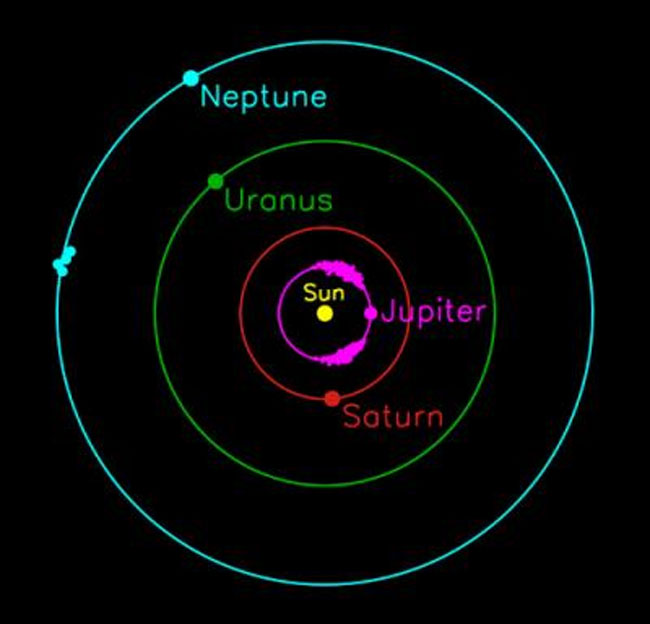Neptune May Have Thousands of Escorts

Neptune may be escorted in its orbit by thousands of asteroid-like objects, perhaps more than exist in the entire asteroid belt.
So far, five of these enigmatic bodies, known as Trojans, have been found at one of Neptune's Lagrange points. These are places where the gravity of a planet and that of the Sun interact to create an area of gravitationally stability.
Jupiter's Lagrange regions are home to legions of Trojans, and around 2,000 cluster at these gravity graves along Jupiter's orbit 60 degrees ahead and 60 degrees behind the gas giant.

The first Neptune Trojan was discovered in 2001 as part of the NASA funded Deep Ecliptic Survey at the Lagrange region 60 degrees and 3.1 billion miles (5 billion kilometers) ahead of Neptune.
A further three Neptune Trojans between 37 and 87 miles (60 and 140 kilometers) in diameter and shaded a pale red color have since been identified by Scott Sheppard of the Carnegie Institution of Washington and Chadwick Trujillo of the Gemini Observatory in Hawaiiusing the 6.5-meter Magellan telescope in Chile.
Despite their diminutive size and brightness, the Neptune Trojans quickly betrayed their existence by their distinct motion against background stars. The most recent Trojan discovered by Sheppard and Trujillo is moving at an unusual inclination of 25 degrees relative to the plane of the solar system (the ecliptic).
"The sky we covered searching for Neptune Trojans was all within 1.5 degrees of the ecliptic," Sheppard said. "High inclination objects will spend the majority of their time off the ecliptic. Thus detecting a high inclination Trojan in our survey suggests there is a large population of such objects. In fact, the high inclination objects appear to outnumber the low inclination objects by a ratio of four to one."
Get the Space.com Newsletter
Breaking space news, the latest updates on rocket launches, skywatching events and more!
If so, there would be swarms of Trojans accompanying Neptune, perhaps up to twenty times more than at Jupiter. The sheer number of Trojans Neptune is thought to harbor reveal that these objects are an established part of Neptune's entourage, dating back to shortly after the planet's formation.
"Neptune cannot currently efficiently capture Trojans for long periods of time," Sheppard said. "Just after the planet formation epoch Neptune's orbit was likely much more eccentric due to its interactions with the other planets. Neptune's interactions with the myriad small bodies around its orbit which included comets, Kuiper Belt objects and other debris which formed nearby would have slowly circularized Neptune's orbit."
This process would have trapped many diverse objects at the Neptune Lagrange points irrespective of their inclination. This diversity is exciting as in 2014 we may get the opportunity to see a Trojan up close courtesy of the New Horizons spacecraft currently en-route to Pluto.
"If a Neptune Trojan could be found which the New Horizons spacecraft could image it would be one of the highlights of the mission," Sheppard said. "The Neptune Trojans are very faint and thus hard to observe from our location on Earth. Thus little is known about their surface properties or composition. The Neptune Trojans may be a unique type of solar system object of which no other stable reservoir currently exists."
At present this flyby of a Neptune Trojan is far from a certainty due to the fact that New Horizons will pass 60 degrees behind Neptune through the trailing Lagrange region known as "L5" where no Trojans have yet been identified.
- Cool Facts about Neptune
- Image Gallery: The New Solar System
- Crazy Names: The Solar System's Nomenclature Wars
- Images: New Horizons - Bound for Pluto
- All About Neptune
Join our Space Forums to keep talking space on the latest missions, night sky and more! And if you have a news tip, correction or comment, let us know at: community@space.com.
David Powell is a space reporter and Space.com contributor from 2006 to 2008, covering a wide range of astronomy and space exploration topics. Powell's Space.com coveage range from the death dive of NASA's Cassini spacecraft into Saturn to space debris and lunar exploration.









